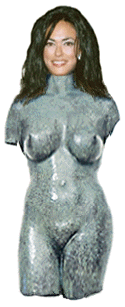...Best of Sicily
presents... Best of Sicily Magazine. ... Dedicated to Sicilian art, culture, history, people, places and all things Sicilian. |
by André Mantegna | ||
Magazine Best of Sicily Arts & Culture Fashion Food & Wine History & Culture About Us Travel Faqs Contact Map of Sicily |
Italy still boasts great directors and actors but Rome is no longer their exclusive base; many work abroad. Movies made locally for Italian consumption are rarely great, even if there have been some gems among them. Maria Grazia's foray into Italian cinema was successful but, considering the environment, not precisely earth-shattering. It concentrated on parts in several forgettable television movies, and a few equally forgettable film roles in things like the Christmas Vacation (Vacanza di Natale) comedies. And she studied English. "Nobody is born speaking two languages," she explained. Then, in 1994, came Il Postino (The Postman), an internationally acclaimed film set in Lipari (off the Sicilian coast, near Maria Grazia's native Messina), in which Cucinotta played the young waitress, Beatrice, courted by the postman, played by the late Massimo Troisi. It was that supporting role that introduced Cucinotta to an audience far beyond Italian shores. The Postman was a charming film, and the last for Troisi, who died shortly before its general release. In her first American film, she co-starred, with Vincent Spano and a distinguished supporting cast, in A Brooklyn State of Mind, which enjoyed a modest success in 1998. Later, she appeared in an episode of the Emmy award-winning television series The Sopranos. She had a memorable part in the opening sequence of the 1999 James Bond movie The World is Not Enough. In an earlier era, scenes like Bond's ultra high-tech speedboat chase up the Thames used to make cinematic history, but no more, and Cucinotta's bad-girl character didn't survive it, anyway. Some of her best work has been in international television productions like Mary Magdalene. More recently, she has had parts in two comedies, Just One Night opposite Timothy Hutton, and Picking Up the Pieces with Woody Allen. Locura de Amor is her first Spanish film. Her "Italianate" image has always been an essential part of her appeal in the international market. While some women seek to be something else, Maria Grazia suffers no such identity crisis. One cannot imagine her as anything other than what she is. The Italian male obsession with blondes prompts otherwise attractive Italian brunettes to make the silly transition to lighter hair and blue-tinted contact lenses, while Italian television suffers from a proliferation of foreign female "personalities" --even Americans and Australians unknown in their native countries. These parochial tastes leave Maria Grazia to be savored by an enlightened few. There's grape juice, there's vinegar, and then there's Cucinotta, the perfect wine. At the conoisseur's altar, one admires style but worships substance. She has rarely posed nude, but her natural affinity with the camera makes her a stunning subject. For Maria Grazia, modelling was an apprenticeship, not an end in itself. She is an actress, pure and simple. Cucinotta has emerged, with the equally talented Monica Bellucci, another dark beauty, as one of the Italian actresses who is best known outside Italy --the kind of duo that hasn't been seen since Loren and Lollobrigida were discovered by foreign fans in the 1960s. Being Italian is only part of the aura of such actresses. Foreign critics have rarely assailed Maria Grazia's talent or versatility. More often, they question her suitability to certain roles, but most agree she has yet to find her perfect vehicle. That's something that could be said of many young actresses. Realistically, it's also a question of just which parts are available, so attractive women like the multifaceted Cucinottas (and Belluccis) often end up portraying Pretty Women who exist as the love interests of male protagonists. In the evolution from model to starlet to actress, beauty can actually become a handicap in some ways. Typecasting aside, serious cinema doesn't always require aesthetically perfect characters Yet beauty, desperately sought by so many, is inescapable. The Cucinotta look is a naturally classic one that makes its own impression, without the help of the overused plastic surgery that has transformed so many women into clones of an adolescent idealist's fantasy. But there are plenty of pretty faces. Maria Grazia's secret weapon isn't anything so superficial. The Mystique. That's what many people --women as well as men-- first recognize when they meet her. It is an innate quality that reveals itself disarmingly, without warning or explanation. It is elusive, never meant to be controlled. It touches you even before you want it to. It can intimidate you even as she tries to put you at ease. Few women, and fewer men, are immune to its effects. Nobody can define it but we know it when we see it. It's not an illusion. There's nothing artificial or contrived about it. It eclipses public image. Transcending mere "star quality," it is a natural elegance, a refined dignity. Patrician by definition if not pedigree, The Mystique is not an intrinsic part of being an actress, a model or even a princess. Instead, it's an easy reserve, almost demure. A certain presence, beyond sensuality or sophistication. An individual thing that assumes a different hue with each woman it colors. Audrey Hepburn had it, and Grace Kelly --and probably Helen of Troy, Cleopatra and a few of Sicily's Greek goddesses. Maria Grazia's nonchalant refusal to do nude scenes ("I don't think it's absolutely necessary for a romantic scene.") only accentuates The Cucinotta Mystique, and being famous only enhances it. One senses that Maria Grazia would have it no matter which field she had pursued. It is grace --grazia-- like her middle name. Few women who have the potential for The Mystique ever learn how to handle it, though some grow into it around thirty. Beauty is one ingredient, certainly, but so is intelligence. Scruples are an essential element, too. The Mystique is elusive, evolving with time. It is for women, not girls. And coming close doesn't count. Then there's the hidden side. The girl next door. Signorina Cucinotta became a Signora in 1995. Maria Grazia lives in Rome with her husband, businessman Giulio Violati, and while she doesn't actually conceal him from public view, she tries to keep her personal life a private affair. Motherhood is her most recent challenge. In the public eye, she has spoken in favor of gay rights but expresses no position on Italy's eclectic politics. "I've never understood Italian politics," she once responded when queried on the subject by an intrusive Italian journalist. Maria Grazia Cucinotta is an utterly respectable woman in a field famous (infamous?) for its bizarre lifestyles. The last Sicilian goddess? Almost. About the Author: André Mantegna writes about entertainment and fashion related topics for several magazines published in Italy and the United Kingdom. This article was written exclusively for publication by Best of Sicily. (Photo illustration, "Cucinotta the Goddess," © 2001 Best of Sicily.) | |
Top of Page |
 Dark, mysterious, naturally seductive. Almost a goddess. There are still a few Italian women who epitomize that classical, captivating look called "Mediterranean." Maria Grazia Cucinotta is one of them. Born at Messina in 1969, she discovered an interest in modeling by the time she was in high school, spending Summers working in Milan. That was when most Italian models were far less voluptuous than the young Cucinotta. Her shapely figure, combined with undiluted ebony hair and eyes and, at 179 centimetres (almost 5 feet 11), a statuesque posture, created a presence that easily overpowered the other girls on the runway. (Leggy blondes beware!) The details of Maria Grazia's face were distinctive yet delicate, bestowing upon her a look decidedly different, more sculpted, as though its creation had been carefully contemplated by Sicily's ancient Greek deities. Her dark eyes were alluring, reflecting light while revealing only what she wanted them to tell you. Fashion designers loved her natural colouring, which complemented contrasts. Anything she wore --black, white, red, yellow-- looked good on her. She worked, briefly, in Italian television, where she effortlessly outshone the untamed legions of semi-talented, small-town beauty queens who populate Italy's inane variety shows. Okay for an occasional guest appearance, perhaps, but not a natural setting for somebody like Maria Grazia. Acting was the next logical step.
Dark, mysterious, naturally seductive. Almost a goddess. There are still a few Italian women who epitomize that classical, captivating look called "Mediterranean." Maria Grazia Cucinotta is one of them. Born at Messina in 1969, she discovered an interest in modeling by the time she was in high school, spending Summers working in Milan. That was when most Italian models were far less voluptuous than the young Cucinotta. Her shapely figure, combined with undiluted ebony hair and eyes and, at 179 centimetres (almost 5 feet 11), a statuesque posture, created a presence that easily overpowered the other girls on the runway. (Leggy blondes beware!) The details of Maria Grazia's face were distinctive yet delicate, bestowing upon her a look decidedly different, more sculpted, as though its creation had been carefully contemplated by Sicily's ancient Greek deities. Her dark eyes were alluring, reflecting light while revealing only what she wanted them to tell you. Fashion designers loved her natural colouring, which complemented contrasts. Anything she wore --black, white, red, yellow-- looked good on her. She worked, briefly, in Italian television, where she effortlessly outshone the untamed legions of semi-talented, small-town beauty queens who populate Italy's inane variety shows. Okay for an occasional guest appearance, perhaps, but not a natural setting for somebody like Maria Grazia. Acting was the next logical step. who resemble supermodels. Lacking talent and credibility, many a model-turned-actress has failed miserably on the big screen. (The Academy Award for "Prettiest Supporting Actress in a Dramatic Role" has yet to be invented.)
who resemble supermodels. Lacking talent and credibility, many a model-turned-actress has failed miserably on the big screen. (The Academy Award for "Prettiest Supporting Actress in a Dramatic Role" has yet to be invented.)